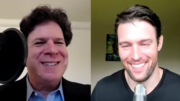
HOW IS THE INTERNET CHANGING THE WAY YOU THINK?
“GO VIRTUAL YOUNG MAN”
Oddly, the Internet is still invisible to the point where many serious thinkers continue to doubt whether it changes modern thought at all.
In science we generally first learn about invisible structures from anomalies in concrete systems. The existence of an invisible neutrino on the same footing as visible particles was predicted in 1930 by Wolfgang Pauli as the error term necessary to save the principles of conservation of energy and momentum in beta decay. Likewise, human memes invisible to DNA (e.g. tunes) were proposed in 1976 by Richard Dawkins as selection, to remain valid, must necessarily include all self-replicating units of transmission involved in tradeoffs with traditional genes.
Following this line of thinking, it is possible that a generalized Internet may even be definable with sufficient care as a kind of failure of the physical world to close as a self-contained system. Were a modern Rip van Winkle sufficiently clever, he might eventually infer something like the existence of file sharing networks from witnessing the collapse of music stores, CD sales, and the recording industry’s revenue model.
The most important example of this principle has to do with markets and geography. The Internet has forced me to view physical and intellectual geography as instances of an overarching abstraction co-existing on a common footing. As exploration and trade in traditional physical goods like spice, silk and gold have long been linked, it is perhaps unsurprising that the marketplace of ideas should carry with it an intellectual geography all its own. The cartography of what may be termed the old world of ideas is well developed. Journals, prizes and endowed chairs give us landmarks to which we turn in the quest for designated thinkers and for those wishing to hug the shore of the familiar this proves a great aid.
Despite being relatively stable, the center of this scientific world began to shift in the last century from institutions in Europe to ones in North America. While there is currently a great deal of talk about a second shift from the U.S. towards Asia, it may instead happen that the next great migration will be dominated by flight to structures in the virtual from those moored to the physical.
Consider the award in 2006 of the Fields medal (the highest prize in mathematics) for a solution of the Poincare Conjecture. This was remarkable in that the research being recognized was not submitted to any journal. In choosing to decline the medal, peer review, publication and employment, the previously obscure Grigori Perelman chose to entrust the legacy of his great triumph solely to an Internet archive intended as a temporary holding tank for papers awaiting publication in established journals. In so doing, he forced the recognition of a new reality by showing that it was possible to move an indisputable intellectual achievement out of the tradition of referee gated journals bound to the stacks of university libraries into a new and poorly charted virtual sphere of the intellect.
But while markets may drive exploration, the actual settlement of the frontier at times requires the commitment of individuals questing for personal freedom, and here the new world of the Internet shines. It is widely assumed that my generation failed to produce towering figures like Crick, Dirac, Grothendieck or Samuelson because something in the nature of science had changed. I do not to subscribe to that theory. Suffice it to say that issues of academic freedom have me longing to settle among the noble homesteaders now gathering on the efficient frontier of the market place of ideas. My intellectual suitcases have been packed for months now as I try to screw up the courage and proper ‘efficient frontier mentality’ to follow my own advice to the next generation: “Go virtual young man.”
This essay was originally published in 2010 at https://www.edge.org/response-detail/11861





